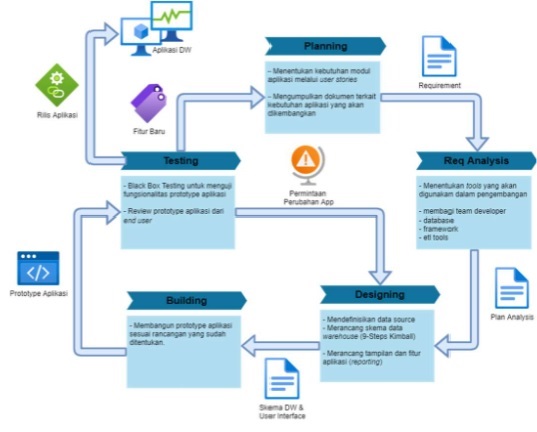Analisis dan Perancangan Data Warehouse Sebagai Penunjang Penyusunan Instrumen Borang Akreditasi Program Studi
Abstract
Eligibility for Study Programs and Higher Education is determined based on the accreditation process. The accreditation criteria refer to the National Higher Education Standards. Nine standards that must be complete with documents in the accreditation process. The process of preparing form instruments is still done manually causing problems in the process of completing form instruments, because they have to recap a lot of data and require more time to retrieve and process the required data. To simplify the preparation of the form instrument, a data warehouse scheme and service-middleware built to collect the data needed in the preparation of the form instrument. The data warehouse schema design will use Kimball's Nine-Steps approach. Meanwhile, application development will use the Agile approach. The results of this research are in the form of data warehouse schema modeling in the Agile development process for the needs of study program accreditation forms.
Downloads
References
[2] unud.ac.id, “Website Universitas Udayana,” Website Universitas Udayana, 2016. https://www.unud.ac.id/ (accessed Aug. 20, 2020).
[3] L. Yessad and A. Labiod, “Comparative study of data warehouses modeling approaches: Inmon, Kimball and Data Vault,” in 2016 International Conference on System Reliability and Science (ICSRS), Paris, France, Nov. 2016, pp. 95–99. doi: 10.1109/ICSRS.2016.7815845.
[4] G. M. F. Ahmed, M. S. Islam, and M. M. R. Karim, “Comparison Between Inmon and Kilball Methodology for the Purpose of Designing, Constructing and Testing of a Commercial BIDW Project,” Int. J. Comput. Graph., vol. 8, no. 1, pp. 11–20, May 2017, doi: 10.14257/ijcg.2017.8.1.02.
[5] R. P. Pawar, “A Comparative study of Agile Software Development Methodology and traditional waterfall model,” IOSR J. Comput. Eng., p. 8.
[6] P. Abrahamsson, O. Salo, and J. Ronkainen, “Agile Software Development Methods: Review and Analysis,” p. 112, 2002.
[7] M. Golfarelli, S. Rizzi, and E. Turricchia, “Sprint Planning Optimization in Agile Data Warehouse Design,” in Data Warehousing and Knowledge Discovery, vol. 7448, A. Cuzzocrea and U. Dayal, Eds. Berlin, Heidelberg: Springer Berlin Heidelberg, 2012, pp. 30–41. doi: 10.1007/978-3-642-32584-7_3.
[8] D. Batra, “Adapting Agile Practices for Data Warehousing, Business Intelligence, and Analytics,” J. Database Manag., vol. 28, no. 4, pp. 1–23, Oct. 2017, doi: 10.4018/JDM.2017100101.
[9] M. Puonti, T. Lehtonen, A. Luoto, T. Aaltonen, and T. Aho, “Towards Agile Enterprise Data Warehousing,” p. 6, Aug. 2016.
[10] R. Gupta, “Using Agile Methodology in Data Warehouse,” vol. 6, no. 12, p. 282, 2016.
[11] P. Surendran, “Technology Acceptance Model: A Survey of Literature,” Int. J. Bus. Soc. Res., p. 4, 2012.
[12] R. H. Shroff, C. C. Deneen, and E. M. W. Ng, “Analysis of the technology acceptance model in examining students’ behavioural intention to use an e-portfolio system,” Australas. J. Educ. Technol., vol. 27, no. 4, Aug. 2011, doi: 10.14742/ajet.940.
[13] M. M. Rahman, M. F. Lesch, W. J. Horrey, and L. Strawderman, “Assessing the utility of TAM, TPB, and UTAUT for advanced driver assistance systems,” Accid. Anal. Prev., vol. 108, pp. 361–373, Nov. 2017, doi: 10.1016/j.aap.2017.09.011.
[14] K. Khotimah, “PERANCANGAN DAN IMPLEMENTASI DATA WAREHOUSE UNTUK MENDUKUNG SISTEM AKADEMIK (STUDI KASUS PADA STKIP MUHAMMADIYAH KOTABUMI),” vol. 02, no. 01, p. 14, 2016.
[15] Y. S. Triana and A. Susilo, “APLIKASI DATA WAREHOUSE UNTUK MENUNJANG STANDAR 3 BORANG AKREDITASI PRODI INFORMATIKA UNIVERSITAS MERCU BUANA,” J. Ilm. FIFO, vol. 9, no. 2, p. 110, Nov. 2017, doi: 10.22441/fifo.2017.v9i2.003.
[16] D. Linda, “PENGISIAN BORANG AKREDITASI STANDAR 3 MENGGUNAKAN,” J. Inform., vol. 15, no. 2, p. 13, 2015.
[17] J. Tunggono, M. R. Faisal, and D. T. Nugrahadi, “PEMANFAATAN DATA WAREHOUSE SEBAGAI SARANA PENUNJANG PENYUSUNAN BORANG AKREDITASI STANDAR 3 DAN STANDAR 4,” vol. 02, p. 14, 2015.
[18] I. M. D. J. Sulastra, M. Sudarma, and I. N. S. Kumara, “PEMODELAN INTEGRASI NEARLY REAL TIME DATA WAREHOUSE DENGAN SERVICE ORIENTED ARCHITECTURE UNTUK MENUNJANG SISTEM INFORMASI RETAIL,” Maj. Ilm. Teknol. Elektro, vol. 14, no. 2, Art. no. 2, Dec. 2015, doi: 10.24843/MITE.2015.v14i02p03.
[19] I. MadeSukarsa, N. Wayan Wisswani, I. K. Gd. Darma Putra, and L. Linawati, “Change Data Capture on OLTP Staging Area for Nearly Real Time Data Warehouse Base on Database Trigger,” Int. J. Comput. Appl., vol. 52, no. 11, Art. no. 11, Aug. 2012, doi: 10.5120/8248-1762.
[20] R. A. Putri, “Evaluasi Model Data Warehouse Untuk Mendukung Manajemen Pendidikan dengan TAM,” vol. 02, p. 5, 2018.
[21] B. David A. and D. Joseph G., “A Comparative Study of Web Development Technologies Using Open Source and Proprietary Software,” Int. J. Comput. Sci. Mob. Comput..


This work is licensed under a Creative Commons Attribution-NonCommercial-NoDerivatives 4.0 International License.

This work is licensed under a Creative Commons Attribution 4.0 International License




